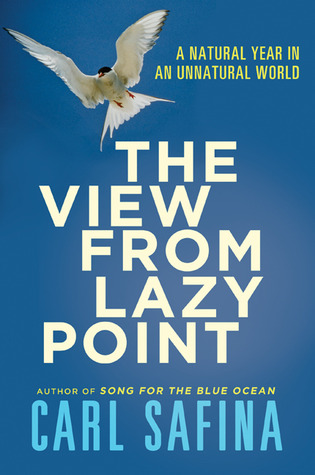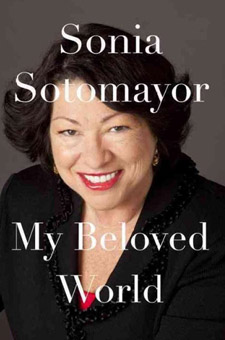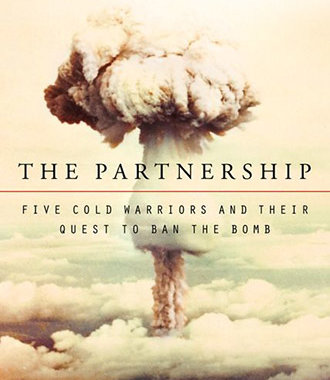The View From Lazy Point: A Natural Year In An Unnatural World by Carl Safina is a book about love. It is not your typical story about a romance in the works or one that goes south. But it is a love story, nonetheless. Love that envelops both humanity and the Earth and everything that lives within and on it. Love that strives to achieve a co-equal and dignified relationship between human beings and nature. Love that understands the interdependent bond between partners, both of which depend on the other for their mutual existence. This is love in its most connected, expansive, and continuous realization, manifested in the circle of life we all experience. This circle of life is threatened, however, by human beings’ demands on the Earth. As Safina points out, we are in a long evolutionary line of species, some now extinct. Could humans also become extinct? It might seem like science fiction, but it could happen if we cannot or will not change our relationship with the Earth. Although Safina does not explicitly say extinction is where we are headed, he suggests this is one possibility: We remain “vitally unaware of how imperiled it [the Earth] is,” he writes. The Earth is the only place we know. If this ark goes down, we all go down with it. Thus, The View From Lazy Point is also a meditation on homo sapiens’ responsibility to the planet on which we exist. Safina encourages us to widen the circle of compassion and to rethink our ingrained economical, ethical, and religious institutions that have set us on this remarkably unwise course. Why are we the way we are? How ought we to live? How can we survive? What ought we to do? These are his big questions.
Carl Safina—marine ecologist, naturalist, conservationist—opens The View From Lazy Point from his beach cottage situated on “a flat peninsula of scrubby pines” jutting out from the eastern edge of Long Island, New York, eleven miles from Montauk Point and one hundred ten miles from Manhattan. Living at Lazy Point, he experiences what he calls the “real real world”—Ruddy Turnstone, Common Tern, Osprey, Blue Fish, Striped Bass, American Horseshoe Crab, Monarch Butterfly, Spring Peeper, Shadbush, Beach Plum, Wax Myrtle, sand dune. Here, with the Long Island Sound to the north and the Atlantic Ocean to the south, “living on the coast presents certain stark realities and a wild, bare beauty. Continent confronts ocean. Weather intensifies. It’s a place of tide and tantrum; of flirtations among fresh-and saltwaters, forests and shores; of tense negotiations with an ocean that gives much but demands more. Every year the raw rim that is this coast gets hammered and reshaped like molten bronze. This place roils with power and a sometimes terrible beauty. The coast remains youthful, daring, uncertain about tomorrow. The guessing, the risk; in a way, we’re all thrill seekers here.” At Lazy Point, he feels alive with wildness, a kind of wildness he experiences when he travels to Southeast Alaska to a rainforest with Black and Brown Bears: “The wild raises a level of alertness that feels alive inside me. It puts the bird back into my chest. What I really want, as always: a genuine moment, a shared glance, connection.”
Safina does not experience time at Lazy Point as linear or arrow-like, but as circular. It is “the circularity of the sky, the ocean’s horizon-in-the-round” that makes up his calendar. Circular time—the flow of the four seasons as they advance and retreat, the migration of seabirds as they fly north or south, the tiny Spring Peeper as it sings in “the breath of spring”–year after year. In chapters for each month of the calendar year, Safina takes the reader on a year’s journey that begins and ends in January at Lazy Point, but a journey that also includes trips to Polar and Solar regions to gain a broader perspective of “the quality of humanity’s relationship with the world.” During this year, he chronicles the nature and habit of his “coast of characters” that beat “to the pulse of a perpetual series of migrations, rivers of life along the leading line of coast.” In the raw month of January, for example, he sees Common Loons, Long-tailed Ducks, King Eiders, Harbor Seals; in February wrens, cardinals, chickadees; in March Great Egrets, Harp Seals, American Oystercatchers, Spring Peepers; in April Great Blue Herons, Glossy Ibis, Ospreys, and the first Ruddy Turnstones. Among the advantages of living in Lazy Point is observing an amazing diversity of animals, including three hundred species of birds that migrate through or breed in the area. He tells his friends “it’s possible to see the whole world in the view from Lazy Point.” His “coast of characters” illustrates his point, but no animal exemplifies Safina’s view that the whole world is a portable place more than the Ruddy Turnstone, “the Arctic-breeding bird that shadows me all over the world.” When he sees a Ruddy Turnstone on his travels to the Caribbean, the Arctic, or the Pacific, he feels at home away from home. He calls them his “globe-traveling companions.”
Having found his life work as a young man on the ocean, Safina’s keen observation of these migrants’ patterns—when they arrive, how long they stay, when they leave, as well as their feeding habits and other ecological needs—is second nature to him. Such awareness turns “‘four seasons’ into a much more complex idea of what life does, what life is, of where life begins and goes.” Just as an animal perhaps perceives time as replaying the same major reel but “every detail different,” Safina also wants us to see life as circular, as the tide ebbs and flows, as the moon waxes and wanes, as the earth revolves around the sun. Safina himself experiences this circularity of time when he remembers, as a kid, “I’d stalk shallow waters with a net in my hand, captivated by shadows of tiny sand-colored fishes fanning away from me. Despite added detail and time, I’m still the minnow-chasing boy.” The structure of The View From Lazy Point mirrors his perception of time as circular, just as the annual migration of birds and fishes and other animals at Lazy Point reinforces his connection with nature and expands the circle of life. For Safina, community is a living world, “connected and fully networked,” and it includes not only humankind, but also the ocean, the air, water, soil, animals, plants, glaciers, coral reefs: the Earth in its mystery, truth, and beauty. Safina notes, “I prefer a community that includes, among many things, sharks.”
Safina’s January-to-January chronicle should be seen not only as a naturalist’s account of the diverse scores of creatures that visit or live there, but also as both a meditation on the imperiled earth and a passionate plea to change our ways: To bend our minds to see the intrinsic connection between us and the living world to which we are related. It is his wish for humanity that we expand the circle of compassion for all living things and act every day mindful of the state of the Earth we are leaving for future generations. Unfortunately, our behavior does not conform to such a commitment. As Safina and other scientists, environmentalists, and human rights advocates observe as they travel around the world, human behavior seems more interested in controlling nature rather than working with it. Safina’s view is blunt: “Human domination has so changed the world as to constitute a new epoch: the new time of humans—the Anthropocene.” He cites Paul Crutzen, a Nobel laureate, who suggests that the Holocene epoch—“whole new time”—is finished. Geologists and others argue about the validity of naming a new epoch based on people being “the dominant force on the planetary surface,” but Safina claims that “as a new force of nature, humans are changing the world at rates and scales previously matched mainly by geological and cosmic forces like volcanoes, ice-age cycles, and comet strikes.”
Safina cites overwhelming evidence to support his view that we are living in a new epoch of human domination: “People are using the world’s forests, fishes, soils, freshwater, and other resources something like 25 percent faster than the world can replace them.” Since 1970, “populations of fishes, amphibians, mammals, reptiles, and birds have declined about 30 percent worldwide” because of overfishing, chemical pollution of water and soil, deforestation, and the killing of animals for sport or commerce. About “40 percent of tropical coral reefs are rapidly deteriorating” as the oceans become more acidic due to warming temperatures. Unregulated fishing has also caused unnecessary damage to unprotected coral reefs. In the last two hundred years the planet’s atmosphere is on a downhill trajectory: The ozone is thinner, carbon dioxide is denser by a third, and nitrogen from synthetic fertilizer has doubled. Since the 1970s, fertilizers have washed down rivers and created “hundreds of oxygen-starved seafloor ‘dead zones’.” Overpopulation, a major concern of Safina’s, has dire consequences for humans and nature. In many parts of the world, instead of growing food locally and regionally on agricultural land, we are building high rises and malls; clear-cutting forests to sell lumber and grow monoculture crops for export; diverting rivers to build dams. Currently, the world population is estimated to be around 7 billion people. By 2050, it is expected to reach between 8 billion and 11 billion. In 2011, China and India, the two most populous countries in the world, have a combined population of 2.5 billion people. To maintain this many people with food, water, and shelter, it would take two earths. We are using up the earth’s resources faster than we can replenish them. How will the world feed an extra 2 billion to 3 billion people when even the United States is falling short today in its “sustainable agricultural carrying capacity?”
The global agricultural system is already in trouble: It is failing to keep up with the demand for food. In 2008, grain shortages—global population growth, climate change, and increased farming for biofuels are some reasons—caused prices to double and triple. Over thirty countries experienced food riots. In 2009, over one billion people were starving or malnourished. Currently, high food prices have contributed to political instability in the Middle East (the “Arab Spring”). In a first-page article published in The New York Times on June 5, 2011, “A Warming Planet Struggles to Feed Itself,” Justin Gillis reports that “farmers need to withstand whatever climate shocks come their way while roughly doubling the amount of food they produce to meet rising demand.” Experts who work in the field and at research institutes warn that people do not understand how climate change will alter future agricultural patterns around the world, even as severe droughts, torrential storms, later frost dates, higher growing temperatures, and increased insect damage point to climate warming as a prominent factor.
In The View From Lazy Point, Safina details his travels to the Polar and Solar regions of the world. On one of these trips—to Svalbard above the Arctic Circle—he visits the Global Seed Vault (the “Doomsday Vault”), established in 2008 by the Global Crop Diversity Trust. Situated underground in a frozen mountain, the storage rooms are maintained at zero degrees Fahrenheit and can store up to 4.5 million samples or 2.25 billion seeds. The vault currently holds about 150 million seeds: “300,000 samples, each with about 500 seeds.” The reason? “To save the future of agriculture.” Cary Fowler, the director of the vault, tells Safina that “agriculture has never seen the kind of climate that is coming”; seed diversity will be a prerequisite for “the drought-and-heat-tolerant crop varieties” farmers will need when global warming causes the temperature to increase beyond a crop’s growing range. The vault is one resource from which new varieties of seeds can be developed. Safina writes: “Water requirements, light sensitivity, heat sensitivity, disease and insect resistance—all must be tuned, then fine-tuned. Even with genetic engineering, it takes about seven years to develop a new crop variety. This vault preserves those tunable traits from around the globe.” The Global Seed Vault houses “a common heritage of humanity.” This is a very good thing because “the Arctic is warming about twice as fast as the rest of the globe.”
The problem with climate change is a thorny one. Skeptics have convinced a lot of people that climate change is not real, and even if it is, so what? We will adapt. Denial, perhaps, is an inevitable response when the problem is so huge. To be sure, adaptation is one answer, but how do you adapt when countries do not have the resources and the money to respond to soaring energy and food prices, record-setting floods and droughts, rising sea levels? In the Pacific Ocean, the island populations of Vanuatu, the Maldives, the Marshall Islands, Kiribati, and Tuvalu are at risk of becoming refugees: Their “average elevation above the sea is only six feet.” Tokyo, Mumbai, and New York City—three of the world’s largest cities—are also exposed to the sea. Millions of people would have to be relocated if their coasts were flooded with ocean water. Bangladesh illustrates what’s in store if the sea level rises three feet. According to the World Bank, “30 million people will have to squeeze inland, while half of Bangladesh’s rice fields will be spoiled by saltwater.” Vanuatu was “the first official sea-level-related relocation to higher ground”—in 2005. The world is scarcely paying attention. Who had heard? When sea levels rise, hundreds of millions of people will have to be relocated, a burdensome and expensive job. Seabirds, too, Safina reminds us—millions of them—will lose their nesting grounds.
Safina summarizes the risks we are facing. “Endangered species. Human poverty. Human encroachment. Forest destruction. Ocean depletion. Pollution. Climate and ocean chemistry change.” These environmental problems are the consequences of humankind’s behavior toward the earth. If ever you need a list to confirm Safina’s statement that “the entire world has encountered us,” this is it. In order to get “control of the vehicle we’re driving,” Safina argues, we must see the big picture—our ecological relationship with the planet itself. Given the environmental problems listed above, it seems we humans are, indeed, driving a vehicle we cannot or will not control. As the dominant species, will we face our responsibilities?
Sometimes, when people confront a complex problem, they need to understand what it is, how it came to be, and what will happen if it is not solved. Once they understand a problem and the consequences if it is not solved, they choose either to do something about it or walk away from it. Almost always, people need perception, insight, and will, along with emotional courage and mental fortitude, to solve it. In the process, they may discover something about themselves that will inevitably change how they perceive themselves and the world around them—their individual makeup and the physical environment in which they find themselves. Change is a difficult task for many people, and some will not attempt it. But if the stakes are high enough, most people will rally to the cause and act to change a situation if it is dire enough. Such is the situation with our imperiled Earth. Will we perceive all of life as interconnected? Will we act as a community in harmony with nature? Will we enlarge the circle of compassion to include everything? How?
Safina is an intelligent writer and a great storyteller, and he surprises with metaphors that stun. He is also a visionary who digs beneath the surface of a consumer-oriented society to reveal why our current thinking and beliefs—the “framework with which we run our lives and our world”—will no longer work to right an endangered planet. He writes: “Our economic, religious, and ethical systems ride antique notions too narrow to freight what we’ve learned about how life works on our sparkle dot of diamond dust in space. These institutions resist change; to last this long, they had to. But they lack mechanisms for incorporating discoveries about how life operates…. The institutions haven’t adjusted to new realizations about how we can push the planet’s systems into dysfunction.” Safina’s cogent analysis of our economic, religious and ethical systems helps us to understand why our “old thinking” needs to change. Change is essential to paradigmatic shifts, but the general population does not readily accept such shifts. They are complex, slow to effect, and not easily understood, as Darwin discovered when he published his theory of evolution in On the Origin of Species in 1859. (His theory continues to generate controversy among a segment of the population.) Safina’s answer is simple in its formulation but profoundly radical in its implications: “I have come to see,” he writes, “that the geometry of human progress is an expanding circle of compassion. And that nature and human dignity require each other. And I believe—that if the word ‘sacred’ means anything at all—the world exists as the one truly sacred place.”
Safina is a marine ecologist. He views life from a scientist’s perspective. Life started in water. It is related by lineage. We all share the same world history: “All the creation myths that intuit a single origin for people are essentially correct. All life is of the same kind: a DNA framework and its consequent window dressing. There is one tree, one family of life, no other.” Thus, life is continuous from its origin to the present; nature preserves the process of life, and as long as the “living enterprise” continues the process will continue. Life is “a network including not just all living things but the energy and nonliving matter that flows through the living, making and keeping all of us alive as we make it alive.”
Safina writes that “forests grow salmon” and “salmon also grow forest.” How does this happen? On one of his Polar trips, he visits Anan Creek in the Wrangell area of Southeast Alaska to see how Alaska has saved its salmon industry and protected its wildlife. With his guide, he enters a rainforest that is so lush it is “as darkly near to enchanted as anything the imagination might conjure.” The forest stream they visit is stacked with thousands and thousands of Pink Salmon ascending the stream in which they originally hatched. Black and Brown bears feast on the salmon; so do the Bald Eagles lined up on the sandbars. They pick and choose among the densely packed fish and single out ripe females with their “fat-rich, energy-dense eggs.” They carry the salmon from the stream into the nearby forest; the salmon provide food for insects and other invertebrates; they in turn feed insect-eating birds. The salmon-bear-rainforest network of energy works like this: “A fish grows by absorbing and superconcentrating the ocean. Salmon are the ocean incarnate. The salmon run becomes one long self-propelled infusion of ocean nutrients. Even before they hit freshwater, they have plenty of chances for reincarnation: feeding seabirds, seals, sea lions, porpoises, and Killer Whales. By the time they begin ascending streams, there is no turning back. They’ve ceased being mere fish and turned themselves into delivery packages of ultraconcentrated nourishment.” Thus, salmon feed the bears that carry them back to the forest to be released as “protein and fat and nitrogen and phosphorus and more. These forests are where the ocean comes to die—and be reborn as trees.” Forests grow salmon. Salmon grow forest. Flowing energy and flowing materials.
If there is a main theme in The View From Lazy Point it is this: “We are a relationship to the world.” Safina explains it in this way: “All lives depend on how energy pushes matter through plants and animals. Often the matter, like carbon, nitrogen, and water, cycles from one living thing to the next through the whole community. We are these dynamic processes in relationship to one another. We are a relationship to the world.” This relationship cannot be exclusively determined only through human-to-human or spiritual interaction, but it must also include all living and non-living things to ensure “its own longevity and continuity of the living enterprise.” Safina asserts that ethicists have ignored the “things that matter in the long run—life-supporting systems and the very cycles that produce and facilitate people, culture, living things, and the future….” We continue to believe, in spite of Darwin, that “man” is at the center of the universe; he is the apex of creation; he can use nature however he sees fit. Such attitudes do not reflect Darwin’s greatest insight: All the world is kin. His “insights blurred lines and blended borders,” Safina emphasizes, “placing us on a continuum of lineage and time, in an organic tree of life.” Such an understanding of humankind’s relationship to the world requires a different ethics than what is evident in today’s world. It requires a sustainable economical model, one that is based not on growth but on development, one that shifts from combustion to renewable energy, for example, and allows people to enjoy life with less stuff. It—this sustainable economical model—would also recognize that, according to Safina, that the “mother of economies” is the planet itself, and the growth model that is now the engineer driving the economy “sits entirely within the ecology.” According to Safina, development looks like: “education, vocational training, democracy, human rights; better tech, better-quality goods and services; fair health care; better family time; clean air and water; clean energy; art, beauty, wildlife, civility.” Sound utopian? Safina’s answer: “Focusing on improvement wouldn’t be the worst thing in the world.” In other words, development means quality, whereas growth means quantity.
The View From Lazy Point is a love story, but the fullness of it includes the possibility of a heartbreaking ending. Safina refuses to go there. He writes with hope that we, as a species, will include the Earth in our daily lives, remembering that it is, as far as we know, the only place we call home. We can no longer afford to objectify our planet and call it “the other” any more than we can objectify our children and grandchildren whom we love and protect. We must find a course of action that reverses the harms and risks to the Earth that Safina cites in his book, and take to heart his mantra: We are a relationship to the world. We are a mystery, a miracle, and DNA all at the same time.
Safina tells a story about himself that answers the question: How will we ensure our longevity on this planet and preserve the process? He used to lie in his boat late at night, “listening to radio calls from ships to families ashore. There was only one conversation, and it boils down to these words, repeated each time: ‘I love you and I miss you, come home safe.’” This is the love we all seek. We must also render it to our planet Earth.



